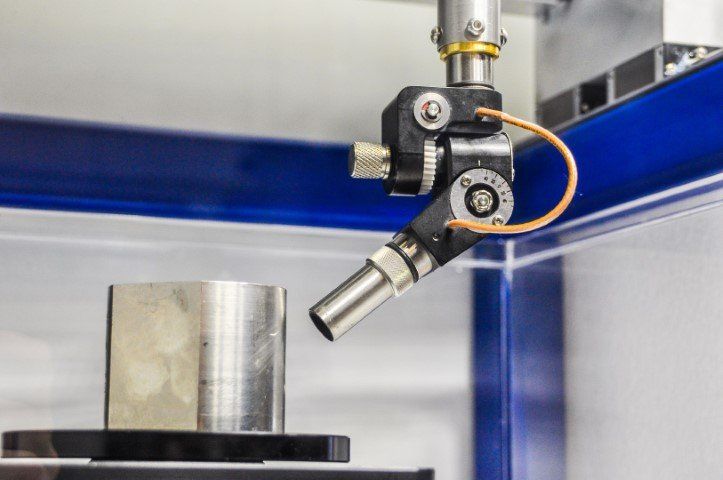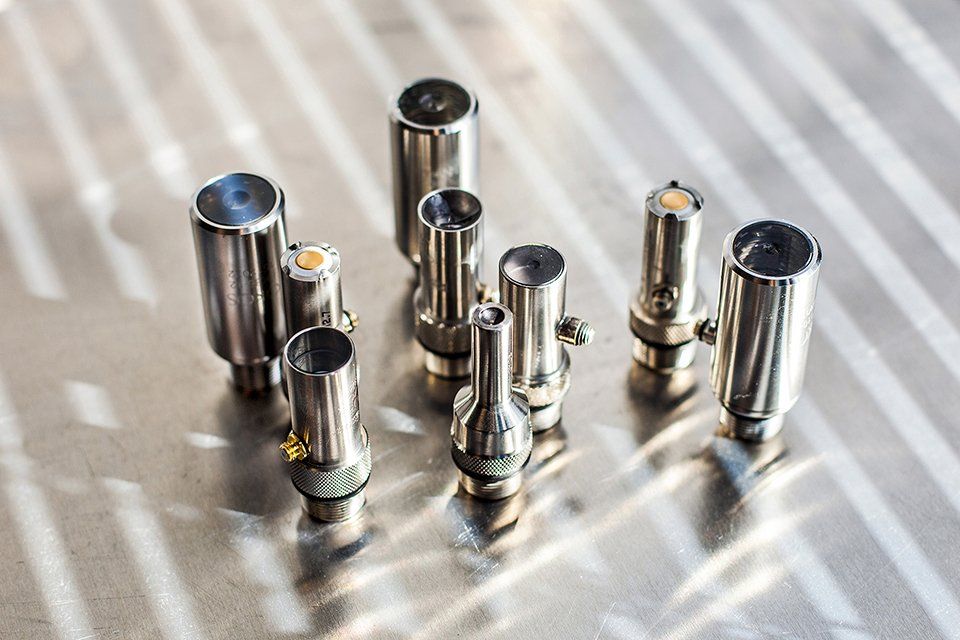Transducers
What is a Transducer?
Transducer is an energy conversion device that generates ultrasonic waves when a voltage is applied to them and can turn ultrasonic waves back into voltage. By applying a voltage to the piezoelectric crystals, oscillations are generated at a specific frequency to produce ultrasonic waves. Combined with the shape of the lens on the transducer, frequency and focal length can be controlled to provide the best results when inspecting the internal characteristics of samples.
All ultrasonic scanning systems use at least one transducer in their processes. The transducer is responsible for generating the analog waveform, which is further amplified by a pulser/receiver and sent back to the digitizer.
Transducers designed by OKOS
OKOS offers a large variety of transducers up to 300 MHz for different applications. We can custom engineer Transducers for specific applications to suit your needs. Continuous innovation, using new construction techniques, keeps OKOS transducers as the top performing probes for SAM. PVA TePla Analytical Systems GmbH has an automated factory in Jena, Germany, focused on precision, high end reliable transducers. OKOS systems benefit for this high end German technology to provide premium solutions to customers.
How to choose a Transducer?
Some transducers require direct contact with a material in order to operate, others use an air gap or are immersed in a fluid, usually water, in order to better transmit the sound through a material. Transducers come in a variety of sizes and shapes for different applications.
OKOS offers 4 types of transducers for customer applications:
Epoxy – Epoxy tipped transducers tend to be less than 30 MHz and are useful for imaging thick samples or samples with very attenuative material. These often have the largest focal lengths.
PVDF – PVDF transducers have a gold tipped exposed element for imaging. They have frequencies in the range of 35 MHz to 75 MHz. They are well suited for thinner samples with attenuative layers such as silicon-based chips. Most focal lengths range from 0.25 inches to 1.5 inches.
Delay Line – Delay Line transducers are quartz lens tipped transducers with internal crystals manufactured to a precise thickness to control frequency. These transducers can range from 35 MHz to 300 MHz, have the best depth of field, and can have custom focal lengths.
Phased Array – Phased array transducers contain multiple elements unlike the single element in other transducers. The transducer can also be curved in shape. This allows for faster scans as the elements simultaneously brush over samples and faster scans of curved surfaces. Using constructive interference between the elements, focal lengths can be changed at any time to achieve the best results. Phased array transducers are typically 20 MHz or below.
Transducers
What is a Transducer?
Transducer is an energy conversion device that generates ultrasonic waves when a voltage is applied to them and can turn ultrasonic waves back into voltage. By applying a voltage to the piezoelectric crystals, oscillations are generated at a specific frequency to produce ultrasonic waves. Combined with the shape of the lens on the transducer, frequency and focal length can be controlled to provide the best results when inspecting the internal characteristics of samples.
All ultrasonic scanning systems use at least one transducer in their processes. The transducer is responsible for generating the analog waveform, which is further amplified by a pulser/receiver and sent back to the digitizer.
Transducers designed by OKOS
OKOS offers a large variety of transducers up to 300 MHz for different applications. We can custom engineer Transducers for specific applications to suit your needs. Continuous innovation, using new construction techniques, keeps OKOS transducers as the top performing probes for SAM. PVA TePla Analytical Systems GmbH has an automated factory in Jena, Germany, focused on precision, high end reliable transducers. OKOS systems benefit for this high end German technology to provide premium solutions to customers.
How to choose a Transducer?
Some transducers require direct contact with a material in order to operate, others use an air gap or are immersed in a fluid, usually water, in order to better transmit the sound through a material. Transducers come in a variety of sizes and shapes for different applications.
OKOS offers 4 types of transducers for customer applications:
Epoxy – Epoxy tipped transducers tend to be less than 30 MHz and are useful for imaging thick samples or samples with very attenuative material. These often have the largest focal lengths.
PVDF – PVDF transducers have a gold tipped exposed element for imaging. They have frequencies in the range of 35 MHz to 75 MHz. They are well suited for thinner samples with attenuative layers such as silicon-based chips. Most focal lengths range from 0.25 inches to 1.5 inches.
Delay Line – Delay Line transducers are quartz lens tipped transducers with internal crystals manufactured to a precise thickness to control frequency. These transducers can range from 35 MHz to 300 MHz, have the best depth of field, and can have custom focal lengths.
Phased Array – Phased array transducers contain multiple elements unlike the single element in other transducers. The transducer can also be curved in shape. This allows for faster scans as the elements simultaneously brush over samples and faster scans of curved surfaces. Using constructive interference between the elements, focal lengths can be changed at any time to achieve the best results. Phased array transducers are typically 20 MHz or below.



